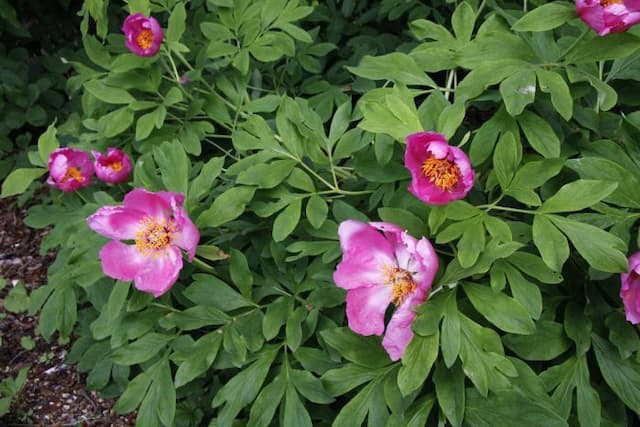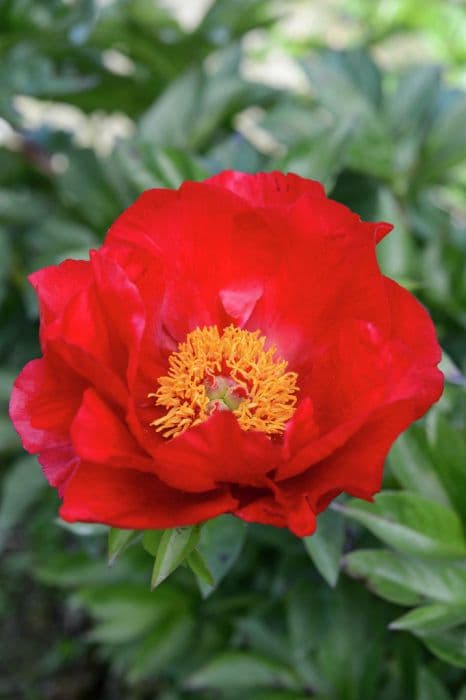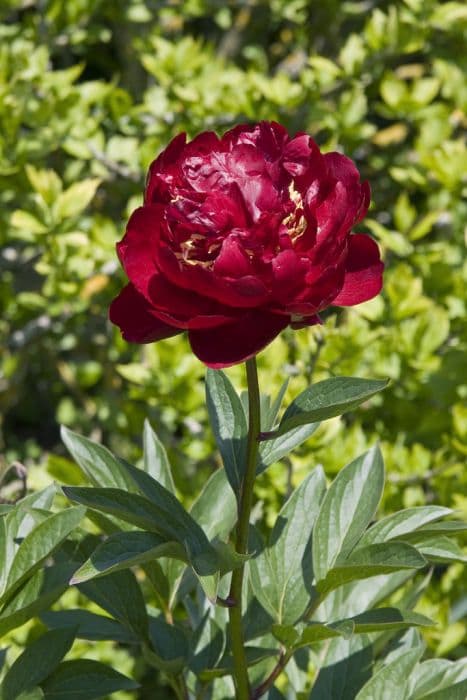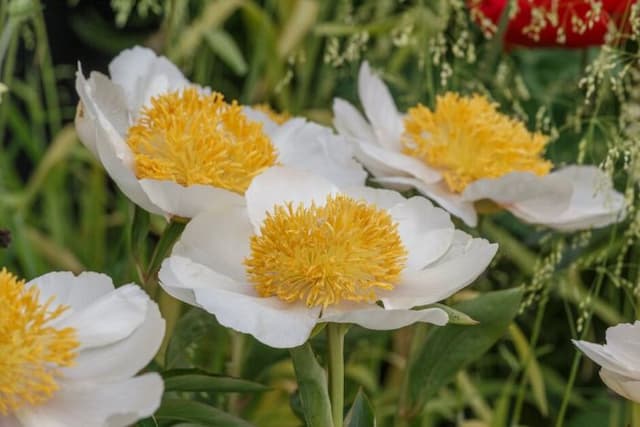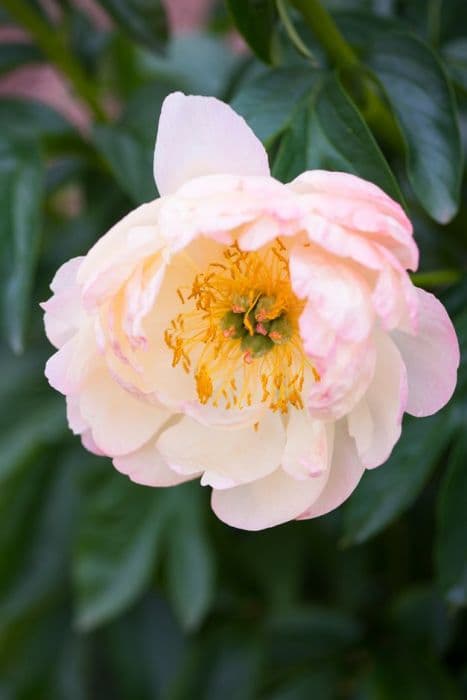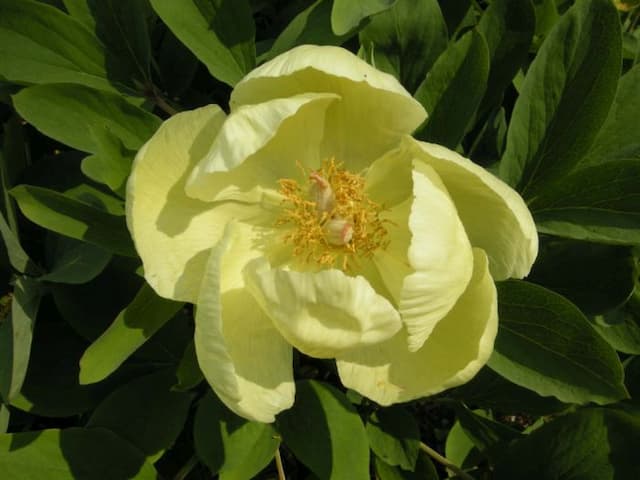White Peony Paeonia lactiflora 'Whitleyi Major'

ABOUT
The peony 'Whitleyi Major' boasts large, fragrant white flowers that exude elegance and charm. The petals are arranged in a dense, full double form, giving each bloom a lush, almost ruffled texture that invites one to lean in for a closer look and a gentle sniff. The outer petals may show a hint of blush before they fully open, adding a touch of softness to their appearance. At the heart of each flower, a cluster of golden-yellow stamens peeks through the white petals, providing a bright contrast that further accentuates the pure beauty of the blossom. These striking flowers sit atop sturdy stems, each a work of art in its own right. The leaves of 'Whitleyi Major' are deep green with a glossy finish, forming an attractive backdrop that makes the white blooms stand out even more in the garden. This plant's foliage may occasionally showcase a wavy edge, adding texture to the overall visual presentation of the plant. The peony 'Whitleyi Major' blooms in late spring to early summer, becoming a showpiece in any setting where it is planted. Its timeless elegance and captivating fragrance make it a cherished addition to cut flower arrangements and garden landscapes alike.
About this plant
 Names
NamesFamily
Paeoniaceae
Synonyms
Chinese Peony, White Peony
Common names
Paeonia lactiflora 'Whitleyi Major'.
 Toxicity
ToxicityTo humans
The peony is generally considered to be of low toxicity to humans. Ingesting parts of the peony plant may cause mild stomach upset, but it is not commonly associated with serious poisoning. However, it's important to remember that even nontoxic plants can pose risks if consumed in large quantities or by individuals with specific allergies.
To pets
Peonies, including the Paeonia lactiflora 'Whitleyi Major', are considered to be possibly toxic to pets, particularly cats and dogs. If ingested, they can cause gastrointestinal upset, including vomiting and diarrhea. In most cases, the symptoms are mild, but it is still advisable to prevent pets from consuming the plant to avoid any negative health effects.
 Characteristics
CharacteristicsLife cycle
Perennials
Foliage type
Deciduous
Color of leaves
Green
Flower color
White
Height
2-3 feet (0.6-0.9 meters)
Spread
2-3 feet (0.6-0.9 meters)
Plant type
Herb
Hardiness zones
3-8
Native area
China
Benefits
 General Benefits
General Benefits- Ornamental Value: Paeonia lactiflora 'Whitleyi Major', commonly known as White Peony, adds visual appeal to gardens with its large, fragrant white flowers.
- Landscape Design: It serves as an excellent border plant, and its compact growth habit makes it ideal for small gardens and landscape designs.
- Pollinator Attraction: The flowers attract pollinators such as bees and butterflies, aiding in garden pollination and promoting biodiversity.
- Longevity: Peonies are known for their longevity, often living for decades and can be a lasting addition to any garden.
- Low Maintenance: Once established, peonies require minimal care beyond occasional watering and fertilizing, making them suitable for gardeners of all skill levels.
- Seasonal Interest: White Peony marks the spring season with its blooms, offers lush green foliage in summer, and sometimes provides attractive fall colors.
- Cut Flowers: Blooms make excellent cut flowers, with a vase life of about a week giving indoor decoration possibilities.
 Medical Properties
Medical Properties- Anti-inflammatory: Paeonia lactiflora 'Whitleyi Major' has been traditionally used for reducing inflammation.
- Analgesic: It has compounds that may have pain-relieving properties.
- Antispasmodic: The plant is said to help relieve muscle spasms.
- Immunomodulatory: There could be elements within that modulate the immune system.
- Antioxidant: Contains antioxidants which can help in preventing oxidative stress.
 Air-purifying Qualities
Air-purifying QualitiesThis plant is not specifically known for air purifying qualities.
 Other Uses
Other Uses- Paeonia lactiflora 'Whitleyi Major', commonly known as white peony, can be used in cut flower arrangements due to its large, fragrant blooms that are highly valued for their aesthetic appeal in floral design.
- The plant's petals can be incorporated into potpourri mixtures, providing a light, pleasant fragrance and adding a touch of elegance to the blend.
- Dried white peony petals can serve as a natural dye for textiles, imparting a subtle color to fabrics without the use of synthetic chemicals.
- The white peony's blossoms can be used to decorate cakes and desserts, as the petals are considered safe for culinary decoration when grown organically.
- In some traditions, the petals of the white peony are scattered at weddings as a symbol of good fortune and a happy marriage.
- Fresh petals of the white peony can be gently pressed and used in crafting personalized invitations or greeting cards for a touch of natural beauty.
- The plant's seed pods may be used in dry floral arrangements for their unique texture and shape, adding an interesting visual element.
- The foliage of the white peony, with its deep green color, can be used in garden landscape designs to create contrasting textures among other plants.
- The spent flower blooms can be used in composting to enrich the soil and help maintain moisture levels due to their organic matter content.
- Enthusiasts of the white peony sometimes gather the fall leaves for use in autumnal crafts and decorations, as they turn to a golden yellow color.
Interesting Facts
 Feng Shui
Feng ShuiThe Peony is considered in Feng Shui to bring good fortune and prosperity, particularly in the aspect of romance. It should be placed in the southwest sector of a garden or home to enhance relationship luck. As Peonies are also seen as a symbol of beauty, they are believed to support a youthful and vibrant energy.
 Zodiac Sign Compitability
Zodiac Sign CompitabilityThe Peony is not used in astrology practice.
 Plant Symbolism
Plant Symbolism- Prosperity: Paeonia lactiflora, commonly known as the Chinese peony, has been associated with wealth and honor. Its lush, full blooms are reminiscent of abundance.
- Romance: As a flower often found in wedding bouquets, the Chinese peony is symbolic of love and romantic relationships, with its luxurious appearance symbolizing the beauty and happiness of marriage.
- Feminine beauty: With its delicate, layered petals, the Chinese peony is often seen as representing the ideal of feminine beauty and gentility.
- Compassion: The soft, round shape of the peony blooms suggests empathy and compassion, making the flower a symbol for nurturing and care.
- Good fortune and happiness: In many cultures, the Chinese peony is a symbol of good luck, often used in celebrations to wish someone happiness and prosperity in their life ahead.
 Water
WaterWhite peony needs consistent moisture, especially during the summer blooming season. It's best to water deeply once a week, providing about 1 inch of water, which corresponds to roughly 0.623 gallons for a standard garden area of 10 square feet. Ensure the soil is well-draining to prevent waterlogging. During periods of drought or extreme heat, increase watering frequency to maintain soil moisture without oversaturating. It's important to water at the base of the plant to keep the foliage dry and prevent fungal diseases.
 Light
LightWhite peonies thrive in full sun to partial shade. They require at least six hours of direct sunlight per day for optimal growth and flowering. Plant in a spot that receives morning sunlight and some afternoon shade in areas with very hot summers. Avoid overly shady areas which can lead to poor blooming and weak stems.
 Temperature
TemperatureWhite peonies prefer temperate climates and do well in a temperature range of 65°F to 75°F, which is their ideal growing condition. They can survive winter temperatures down to about -20°F and summer highs up to 85°F. However, excessively high temperatures over prolonged periods may stunt growth or reduce flowering.
 Pruning
PruningPrune white peonies in the fall after the leaves have died back to prevent disease and prepare the plant for winter. Remove any dead or damaged stems at ground level. Pruning is not only for aesthetics but also for plant health, as it allows for better air circulation and reduces the risk of fungal diseases. The best time for major pruning is late autumn, while light trimming can be done in spring to shape the plant as needed.
 Cleaning
CleaningAs needed
 Soil
SoilPeony 'Whitleyi Major' thrives in well-draining, fertile loam with a neutral to slightly alkaline pH of 6.5 to 7.5. A mix of garden soil, compost, and perlite helps ensure good aeration and nutrient supply.
 Repotting
RepottingPeonies like 'Whitleyi Major' seldom need repotting and prefer to be left undisturbed, transplant if necessary every 10-15 years or when clumps become very crowded.
 Humidity & Misting
Humidity & MistingPeony 'Whitleyi Major' tolerates typical outdoor humidity levels and does not require specific humidity adjustments.
 Suitable locations
Suitable locationsIndoor
Not ideal for indoors; peonies need chilling winters.
Outdoor
Plant in sunny spot with well-draining soil; mulch in winter.
Hardiness zone
3-8 USDA
 Life cycle
Life cycleThe life cycle of Paeonia lactiflora 'Whitleyi Major', commonly known as Chinese Peony 'Whitleyi Major', starts with seed germination, which requires a period of cold stratification to break dormancy. Following germination, the plant develops a root system and a shoot that emerges from the soil, forming a small rosette of leaves. This perennial plant then enters a vegetative stage, where it focuses on leaf and stem growth, storing energy in its underground tuberous roots. Once mature, which can take several years, the plant produces large, fragrant white flowers in late spring to early summer, usually during its third year. After blooming, it sets seed in the form of a capsule that ripens, dries, and releases seeds to start a new generation. The plant then goes dormant in fall, with its above-ground foliage dying back, and it relies on its roots to survive the winter and regenerate the following spring.
 Propogation
PropogationPropogation time
Spring to Early Summer
Paeonia lactiflora 'White Wings', commonly known as Chinese peony, is most successfully propagated through division, which is ideally done in the fall after the plant has gone dormant. To propagate by division, carefully dig up the peony clump and wash off the soil to reveal the root system. Look for sections of the root that have at least three to five eyes, which are the small reddish buds from which new stems will grow. Using a sharp and sterile knife, cut the root into sections, ensuring each division has a sufficient number of eyes and a portion of the root system. These sections can then be replanted in a well-drained soil at a depth such that the eyes are approximately 1 to 2 inches (2.5 to 5 centimeters) below the soil surface, allowing each division plenty of space to grow. Water the newly planted divisions thoroughly and wait for them to establish and grow into new peony plants, which can take a few years to mature and bloom fully.
